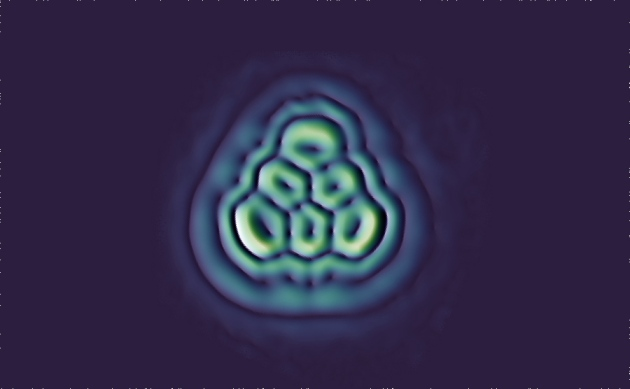
IBM Research physicist Leo Gross and his team have made a triangular molecule that can be used to make quantum computers. Conventional chemistry has been unable to produce the molecule, called triangulene.
The molecule looks as though it was cut from graphene, a single-atom layer of carbon in which the atoms are arranged in hexagons, but the carbon atoms in the corners of triangulene bond to a hydrogen atom. Because electrons like to pair up, a molecule that has free electrons is highly reactive, making it unstable. Triangulene has two free electrons, making it very difficult for chemists and physicists alike to construct.
The creation of a molecule relies on chemical reactions because of the small size of molecules. Triangulene is less than one-millionth the width of a piece of human hair, so it cannot be manipulated directly. In 2009, Gross’s team of physicists built a machine that had the capability to image molecules at the atomic level by placing the molecule in question on a copper surface covered in salt. Then, the copper is placed in a vacuum at extremely low temperatures and introduced to a fine gold tip containing a single molecule of carbon monoxide. The gold tip is moved over the molecule, which gets rolled back and forth by the repelling forces of molecules coming in close contact. The path traced by the tip is interpreted and read by a machine, which converts it to an image.
The team at IBM has imaged molecules like olympicene, which gets its name from the distinctive linking of rings resembling the Olympic symbol. They’ve also imaged molecules in intermediate states of chemical reactions. The images are far from perfect, but the grainy pictures tell chemists all they need to know.
Triangulene was made when the team of researchers at IBM acquired its predecessor from chemists at the University of Warwick. This molecule had two extra hydrogen atoms instead of triangulene’s free electrons. As in their imaging studies, Gross and his team deposited the University of Warwick’s molecule on a copper surface and inspected it with a gold tip containing carbon monoxide. Then they aimed voltage pulses down the tip to remove the two hydrogen atoms. This left them with two free electrons — and made triangulene. The molecule retained stability for up to four days.
Gross is pleased with his team’s progress, as chemists have been trying and failing to replicate the molecule. Think of it as a sort of physicist/chemist rivalry, though the discovery is also practical in nature. Upon testing, Gross’s team discovered that the two free electrons had the same spin and, like all electrons, carried a negative charge. Electrons can spin either clockwise or not, though these spins can be manipulated.
This application for molecules may be relevant to quantum computers, in which only a few quantum bits are necessary to create a machine many times as powerful as the best computers powered by silicon chips. Though creating a molecule like triangulene by hand is far from efficient, it doesn’t take as many to accomplish a major breakthrough.
Source: Quartz
Image source: Nature
Advertisement
Learn more about Electronic Products Magazine





